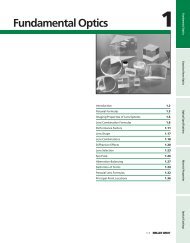datasheet: pdf
datasheet: pdf
datasheet: pdf
You also want an ePaper? Increase the reach of your titles
YUMPU automatically turns print PDFs into web optimized ePapers that Google loves.
APPLICATION INFORMATION<br />
AM26LV32<br />
LOW-VOLTAGE HIGH-SPEED<br />
QUADRUPLE DIFFERENTIAL LINE RECEIVER<br />
SLLS202D – MAY 1995 – REVISED APRIL 2000<br />
fail-safe conditions<br />
The AM26LV32 quadruple differential line receiver is designed to function properly when appropriately<br />
connected to active drivers. Applications do not always have ideal situations where all bits are being used, the<br />
receiver inputs are never left floating, and fault conditions don’t exist. In actuality, most applications have the<br />
capability to either place the drivers in a high-impedance mode or power down the drivers altogether, and cables<br />
may be purposely (or inadvertently) disconnected, both of which lead to floating receiver inputs. Furthermore,<br />
even though measures are taken to avoid fault conditions like a short between the differential signals, this does<br />
occur. The AM26LV32 has an internal fail-safe circuitry which prevents the device from putting an unknown<br />
voltage signal at the receiver outputs. In the following three cases, a high-state is produced at the respective<br />
output:<br />
1. Open fail-safe – Unused input pins are left open. Do not tie unused pins to ground or any other<br />
voltage. Internal circuitry places the output in the high state.<br />
2. 100-ohm terminated fail-safe – Disconnected cables, drivers in high-impedance state, or<br />
powered-down drivers will not cause the AM26LV32 to malfunction. The outputs will remain in<br />
a high state under these conditions. When the drivers are either turned-off or placed into the<br />
high-impedance state, the receiver input may still be able to pick up noise due to the cable acting<br />
as an antenna. To avoid having a large differential voltage being generated, the use of<br />
twisted-pair cable will induce the noise as a common-mode signal and will be rejected.<br />
3. Shorted fail-safe – Fault conditions that short the differential input pairs together will not cause<br />
incorrect data at the outputs. A differential voltage (V ID ) of 0 V will force a high state at the<br />
outputs. Shorted fail-safe, however, is not supported across the recommended common-mode<br />
input voltage (V IC ) range. An unwanted state can be induced to all outputs when an input is<br />
shorted and is biased with a voltage between –0.3 V and 5.5 V. The shorted fail-safe circuitry<br />
will function properly when an input is shorted, but with no external common-mode voltage<br />
applied.<br />
fail-safe precautions<br />
The internal fail-safe circuitry was designed such that the input common-mode (V IC ) and differential<br />
(V ID )voltages must be observed. In order to ensure the outputs of unused or inactive receivers remain in a high<br />
state when the inputs are open-circuited, shorted, or terminated, extra precaution must be taken on the active<br />
signal. In applications where the drivers are placed in a high-impedance mode or are powered-down, it is<br />
recommended that for 1, 2, or 3 active receiver inputs, the low-level input voltage (V IL ) should be greater than<br />
0.4 V. As in all data transmission applications, it is necessary to provide a return ground path between the two<br />
remote grounds (driver and receiver ground references) to avoid ground differences. Table 1 and Figures 4<br />
through 7 are examples of active input voltages with their respective waveforms and the effect each have on<br />
unused or inactive outputs. Note that the active receivers behave as expected, regardless of the input levels.<br />
POST OFFICE BOX 655303 • DALLAS, TEXAS 75265<br />
7
















